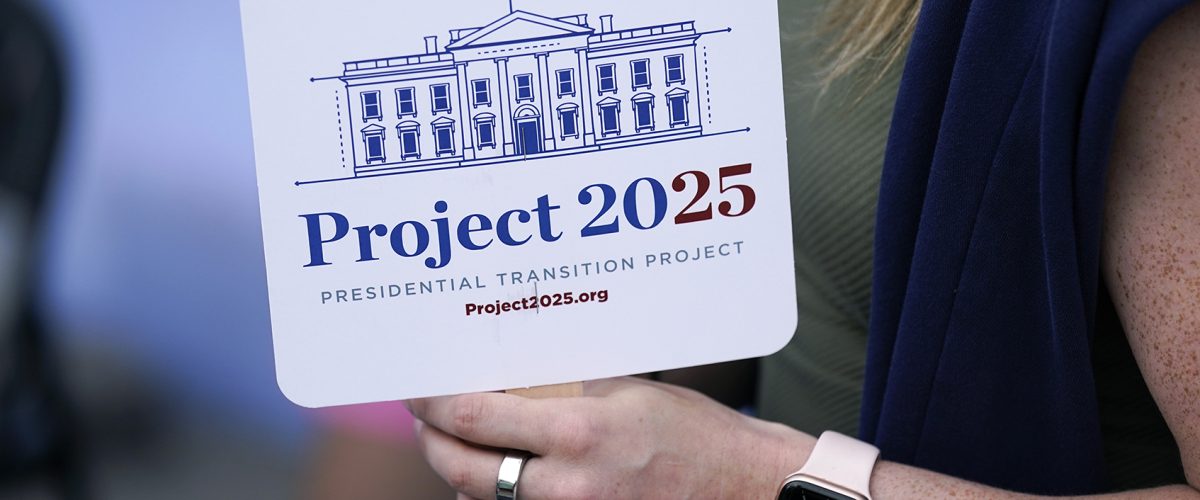The big news today was that Paul Dans, director of “Project 2025: The Presidential Transition Project,” is stepping down from his position at the Heritage Foundation, which spearheaded the project.
The policy blueprint and political playbook is publicly supported by more than 100 conservative advocacy groups, think tanks and colleges, including leading organizations from the Christian right. Its stated goal: “To assemble an army of aligned, vetted, trained and prepared conservatives to go to work on Day One to deconstruct the Administrative State.”
If ever there were a document that could be described as “saying the quiet part out loud,” Project 2025 is it. Since its publication, its overt authoritarianism and policy extremism have been exposed in hundreds of media stories (including an MSNBC segment in which I participated last night), and Donald Trump has tried to distance himself from it as criticism has mounted.
In response to Dans’ resignation today, the Trump campaign put out this statement:
President Trump’s campaign has been very clear for over a year that Project 2025 had nothing to do with the campaign, did not speak for the campaign, and should not be associated with the campaign or the president in any way. Reports of Project 2025’s demise would be greatly welcomed and should serve as notice to anyone or any group trying to misrepresent their influence with President Trump and his campaign — it will not end well for you.
Is Trump lying again?
Trump has been desperately trying to duck questions about Project 2025 over the last few weeks, claiming, “I know nothing about Project 2025” and, “I have no idea who is behind it.” But, of course, we’ve heard this kind of denial before. Trump, for example, repeatedly made similar claims about E. Jean Carroll, the woman a jury determined Trump had sexually assaulted and then defamed, saying “This woman … I don’t know her, I never met her, I have no idea who she is.”
“Trump’s claims to ignorance about Project 2025 are paper thin.”
Like the Carroll case, Trump’s claims to ignorance about Project 2025 are paper thin. Trump has longstanding ties to both the Heritage Foundation and Project 2025’s authors. To name just two, Russ Vought and Ed Martin were architects of both Project 2025 and the official Republican platform recently unveiled at the Republican National Convention.
Vought, who wrote the chapter “Executive Office of the President” for Project 2025, served as a senior member of Trump’s previous administration and is rumored to be a top contender for chief of staff in a second Trump administration. Reporter Judd Legum noted that 31 of the 38 people responsible for writing and editing Project 2025 held positions in either the Trump administration or transition.
Most significantly, there’s a past track record. It turns out the Heritage Foundation developed and delivered a similar “Mandate for Leadership” document to Trump in 2016. The Project 2025 authors note its powerful influence: “Soon after President Donald Trump was sworn in, his administration began to implement major parts of the 2016 Mandate. After his first year in office, the administration had implemented 64% of its policy recommendations.”
The real question is whether Trump is disavowing Project 2025 in name only as a PR strategy or whether he is rejecting its substance. My money is on the former. He’s certainly offered no concrete statement clarifying his rejection of its broad Christian nationalist worldview or denouncing specific extremist policies it contains.
“The real question is whether Trump is disavowing Project 2025 in name only as a PR strategy or whether he is rejecting its substance.”
The most disturbing thing about Project 2025 isn’t its extreme policy and political recommendations but the way it marshals Christian nationalist commitments to distort, beyond all recognition, fundamental American values like life, liberty and the pursuit of happiness.
Life
Project 2025 has particular and wildly inconsistent understandings of “life” that are not widely shared, even among religious Americans. On the one hand, it declares the Department of Health and Human Services “should return to being known as the Department of Life by explicitly rejecting the notion that abortion is health care and by restoring its mission statement… to include furthering the health and well-being of all Americans ‘from conception to natural death.’”
At the same time, it declares that “the next conservative administration should therefore do everything possible to obtain finality for the 44 prisoners currently on federal Death Row. It should also pursue the death penalty for applicable crimes — particularly heinous crimes involving violence and sexual abuse of children — until Congress says otherwise through legislation.”
The pursuit of happiness and liberty
The following passage, located right up front in the Foreword, should send chills up the spines of all Americans who value our Constitution and the freedoms we hold dear in our democracy:
When the Founders spoke of “pursuit of happiness,” what they meant might be understood today as in essence “pursuit of blessedness.” That is, an individual must be free to live as his Creator ordained — to flourish. Our Constitution grants each of us the liberty to do not what we want, but what we ought. This pursuit of the good life is found primarily in family — marriage, children, Thanksgiving dinners and the like.
If you read this passage quickly, it is possible to miss the rhetorical sleight of hand at play here — one that substitutes an impoverished conception of liberty that is captive to a conservative Christian nationalist determination of the good life for true individual liberty determined by each citizen.
Similarly, even the Constitution, in this view, only guarantees liberty if we are pursuing the ends we ought to pursue. The free pursuit of “happiness” is transformed into the pre-ordained path of “blessedness,” and individual “liberty” devolves into something called “ordered liberty.”
“Who determines whether people are pursuing the life, liberty and happiness God intends?”
The problem with this view, of course, is that it begs the question, “Who determines whether people are pursuing the life, liberty and happiness God intends?”
The answer, in a pluralistic democracy, must be that there cannot be one conception of the good life to which all are compelled to conform. This insight — fundamental to democratic political theory — follows as a practical matter in a diverse society of equals, but it also follows from theological humility.
None of us know the mind of God. I also would add this corollary principle: The last people who should be making sweeping, arrogant claims are those who are a part of white Christian traditions, both Protestant and Catholic, that previously and so confidently declared that the God-ordained good life entailed enslaving and oppressing others because of the color of their skin.
The sentence following these disturbing claims about happiness and liberty gives the game away: “The pursuit of the good life is found primarily in family — marriage, children, Thanksgiving dinners and the like.”
White Christian America as the norm
While these are perfectly fine examples of some things most of us, including me, might include in a description of a good life, there is a powerful normative white Christian worldview lurking in those images (and a noncoincidental resonance with JD Vance’s bizarre claims about marriage and children).
I described this nostalgic vision in my 2016 book, The End of White Christian America, this way:
In its heyday, a set of linked institutions reinforced white Christian America’s worldview across generations: The Young Men’s Christian Association, the Boy Scouts, the Masonic Lodge, and the local country club with limits or even outright bans on membership for Catholics, Jews and ethnic minorities. White Christian America had its golden age in the 1950s, after the hardships and victories of World War II and before the cultural upheavals of the 1960s. June Cleaver was its mother, Andy Griffith was its sheriff, Norman Rockwell was its artist, and Billy Graham and Norman Vincent Peale were its ministers.
In short, everything in the remaining 900 pages of Project 2025 follows from this 1950s vision of a white Christian America, where white straight men in child-producing heterosexual marriages wield power and everyone else knows their place.
While the document presents itself primarily as a political and policy blueprint, the normative conservative white Christian biases surface frequently. (Quick culture war sidebar: The word “woke” is invoked 35 times; “abortion” 199 times; “sex” 133 times; “gender” 111 times.)
Here are just a few examples:
- “Today the Left is threatening the tax-exempt status of churches and charities that reject woke progressivism. They will soon turn to Christian schools and clubs with the same totalitarian intent.”
- The next conservative president must make the institutions of American civil society hard targets for woke culture warriors. This starts with deleting the terms ‘sexual orientation’ and ‘gender identity,’ ‘diversity,’ ‘equity’ and ‘inclusion’ ‘gender,’ ‘gender equality,’ ‘gender equity,’ ‘gender awareness,’ ‘gender-sensitive,’ ‘abortion,’ ‘reproductive health,’ ‘reproductive rights’ and any other term used to deprive Americans of their First Amendment rights out of every federal rule, agency regulation, contract, grant, regulation and piece of legislation that exists.”
- “The Dobbs decision is just the beginning. Conservatives in the states and in Washington, including in the next conservative administration, should push as hard as possible to protect the unborn in every jurisdiction in America. … The next president has a moral responsibility to lead the nation in restoring a culture of life in America again.”
- “How much risk mitigation is worth the price of shutting down churches on the holiest day of the Christian calendar and far beyond as happened in 2020? What is the proper balance of lives saved versus souls saved? The CDC has no business making such inherently political (and often unconstitutional) assessments and should be required by law to stay in its lane.”
- “God ordained the sabbath as a day of rest, and until very recently the Judeo-Christian tradition sought to honor that mandate by moral and legal regulation of work on that day.”
- “The president should make clear via executive order that religious employers are free to run their businesses according to their religious beliefs, general nondiscrimination laws notwithstanding.”
This Christian nationalist vision, where conservative white Christian theology dictates the contours of “the good life” for all citizens, is the animating spirit of Project 2025. And that worldview, in turn, authorizes the creation of a blueprint for an authoritarian president who, in the name of God and the people, will set about dismantling democracy as we know it.
If they succeed, they will still speak of life, liberty and the pursuit of happiness. But the rest of us will only be free to do what they believe we ought.

Robert P. Jones
Robert P. Jones serves as president and founder of PRRI and is the author of The Hidden Roots of White Supremacy and the Path to a Shared American Future and White Too Long: The Legacy of White Supremacy in American Christianity, which won a 2021 American Book Award.
This column originally appeared on Robert P. Jones’s substack #WhiteTooLong.
Related articles:
Project 2025’s plan for mass deportations would make food prices soar
Want to know who’s behind Project 2025? Follow the money through the swamp | Analysis by Mara Richards Bim
You’ve heard of Project 2025? Now meet Agenda 47 | Analysis by Steve Rabey
Du Mez, Bass and Tisby warn: Project 2025 is a Christian nationalist blueprint
Heritage Foundation: Reagan’s favorite think tank reborn for Trump 2.0


